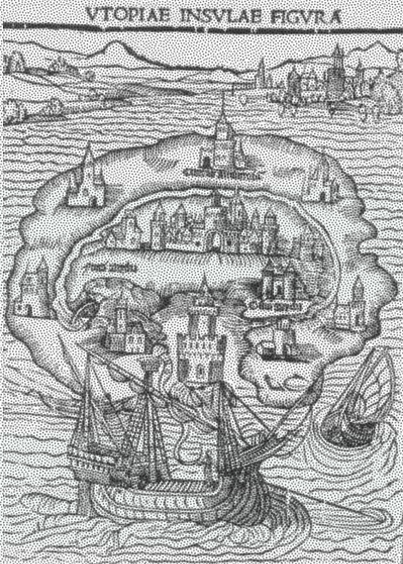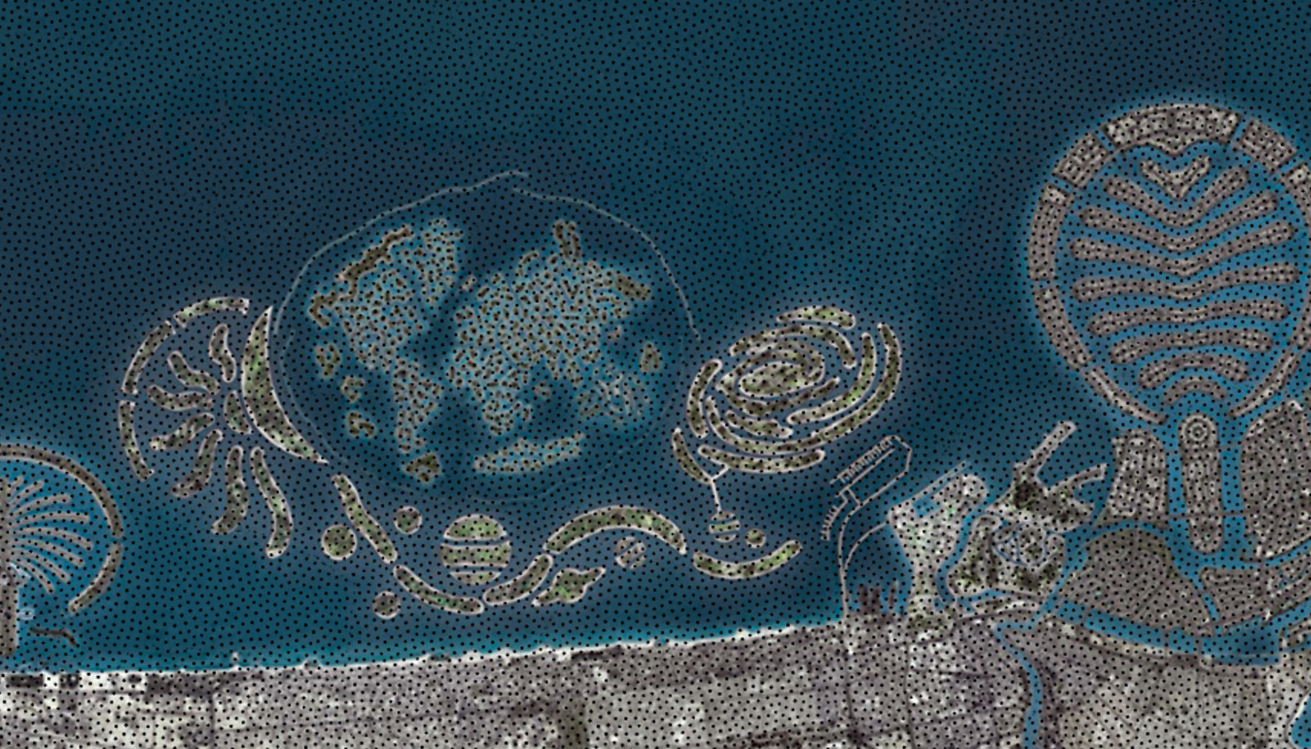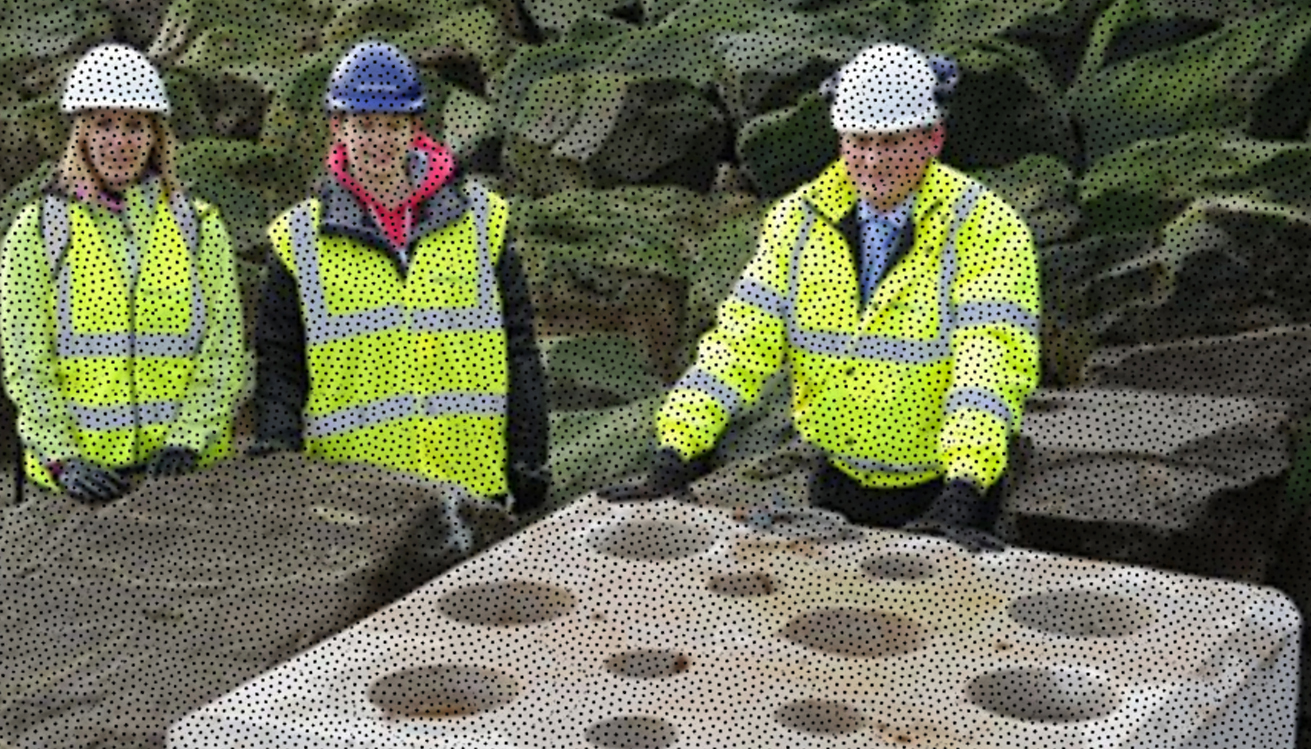Artificial islands:
“Leviathan” Hybrids of Nature
and Technology
For millennia, people have been fascinated by the idea of artificial islands. In Neolithic Ireland and Scotland people lived on defensive wooden islands in lakes called crannógs1Wood-Martin, W.G., 1886. The lake dwellings of Ireland: or, Ancient lacustrine habitations of Erin, commonly called crannógs. Hodges, Figgis & Company.. Construction of the ancient island site of Nan Madol, Micronesia began as early as the 8th century2Athens, J.S., 1980. Pottery from Nan Madol, Ponape, Eastern Caroline Islands. The Journal of the Polynesian Society, 89, pp. 95–99.. Indeed, Thomas More’s (1516) Utopia was an imagined artificial island in which everything was perfect (Figure 1); a concept that has transcended time with many recent artificial islands being designed and promoted as utopian paradises where the global elite can live, work and play in eco-friendly, green and smart cities3Grydehøj, A. and Kelman, I., 2016. Island smart eco-cities: innovation, secessionary enclaves, and the selling of sustainability. Urban Island Studies, 2, pp. 1–24.. Nowhere exemplifies this concept better than myriad artificial islands of Dubai where one can stay in the world’s only 7-star hotel and even own their own artificial island in the shape of their country of choice. Artificial islands have been referred to as hybrids of nature and technology4Jackson, M. and della Dora, V., 2009. “Dreams so big only the sea can hold them”: man-made islands as anxious spaces, cultural icons, and travelling visions. Environment and Planning A, 41, 2086–2104., designed and crafted by humans, for humans, but ultimately existing in natural environments.

Fig. 1
Illustration of the original artificial island by Ambrosius Holbein for the 1516 first edition of Thomas More’s Utopia.
In the field of ecology, “ecosystem engineers” are organisms that can alter their environment to release resources, not only for themselves, but for other species as well. The classic example is the beaver, which cuts down trees to make dams and flood forests. The ultimate ecosystem engineers, however are humans. We have long been designing terrestrial ecosystems to yield services for society5Ross, M.R., Bernhardt, E.S., Doyle, M.W. and Heffernan, J.B., 2015. Designer ecosystems: Incorporating design approaches into applied ecology. Annual Review of Environment and Resources, 40, pp. 419–443., transforming wildlands to agricultural, managed and built landscapes6Ellis, E.C., 2015. Ecology in an anthropogenic biosphere. Ecological Monographs, 85, pp. 287–331.. In coastal environments where human population densities are particularly high and land is scarce, we are turning our attention to the sea. We are converting shallow coastal habitats such as sand and mudflats, saltmarshes, coral reefs and mangroves into artificial islands that are suitable for development. While this is not a new practice, the scale and ambition of such projects have increased since the construction of the Palm Jumeirah, Dubai in 2001. This palm-shaped island is just one of hundreds that were initially designed (Figure 2) as part of the planning for a post-oil economy, with the view to high end tourism and property.

Fig. 2
The planned, but unrealised coastline of Dubai. The Palm Jumeirah (far left) and The World (centre top) do exist today, but the rest of the islands (The Palm Deira and The Universe) still only exist on planning blueprints.
Malaysia is one country that seems to have taken inspiration from Dubai. Since 1988, Malaysia has completed or approved the construction of at least 19 artificial islands7Chee, S.Y., Othman, A.G., Sim, Y.K., Adam, A.N.M. and Firth, L.B., 2017. Land reclamation and artificial islands: Walking the tightrope between development and conservation. Global Ecology and Conservation, 12, pp. 80–95.. In Penang, the east coast of the island is already heavily reclaimed with major artificial island projects underway and planned for the north and south coasts respectively7Chee, S.Y., Othman, A.G., Sim, Y.K., Adam, A.N.M. and Firth, L.B., 2017. Land reclamation and artificial islands: Walking the tightrope between development and conservation. Global Ecology and Conservation, 12, pp. 80–95.. In this instance, the artificial islands were constructed due to lack of suitable space on land for development, and to alleviate traffic. Not only do these artificial islands completely replace whatever habitats preexisted in the receiving environment (e.g. coral reefs, seagrass, mangrove, mud and sand flats) causing habitat and biodiversity losses, but the placement of rock, concrete and metal can and does represent habitat for other species, albeit often different from those that were lost and indeed different to analogous natural habitats8Burt, J.A., Feary, D.A., Cavalcante, G., Bauman, A.G. and Usseglio, P., 2013. Urban breakwaters as reef fish habitat in the Persian Gulf. Marine Pollution Bulletin, 72, pp. 342–350.. This “biodiversity deficit” is attributed to the structures having reduced topographic complexity and typically being located in areas of high disturbance.
In recognition of the need to mitigate and compensate for the impacts of coastal development, the field of ecological engineering strives to make space for nature in the built environment, through engineering interventions. This burgeoning field of research has produced many success stories featuring wide-ranging methods of ecological enhancement on marine artificial structures. Examples include increasing topographic complexity and addition of microhabitats to encourage the recruitment of native species, transplanting of habitats and species that are important from a conservation (e.g. threatened species) or functioning (e.g. mussels that filter seawater and improve water quality) perspective, through to the design of large-scale precast concrete products (e.g. the BIOBLOCK, Figure 3) that can replace and augment artificial structures and provide habitat and shelter for myriad species9Firth, L.B., Thompson, R.C., Bohn, K., Abbiati, M., Airoldi, L., Bouma, T.J., Bozzeda, F., Ceccherelli, V.U., Colangelo, M.A., Evans, A. and Ferrario, F., 2014. Between a rock and a hard place: environmental and engineering considerations when designing coastal defence structures. Coastal Engineering, 87, pp. 122–135..

Fig. 3
The BIOBLOCK: a purpose-built precast concrete biodiversity enhancement unit that can be incorporated into coastal defence structures by replacing boulders. Photo credit: David Thomas.
The scale of the project is very important when weighing up the benefits to nature. If eco-engineering is implemented on very small-scale, or indeed in redevelopment projects, then the net gains for biodiversity and nature can indeed be positive. When a development is very large-scale, as for example in the case of artificial islands, achieving net gains for biodiversity and nature is much more challenging.
The human population is currently 7.8 billion people and is expected to reach over 11 billion by the end of the century. Coastal development is inevitable. Additionally, climate change, sea level rise and increased storm frequency will drive investment in hard coastal protection infrastructure such as seawalls and breakwaters. It is imperative that existing natural habitats are preserved and protected from development. Where development is deemed necessary, redevelopment is advocated over breaking new ground, and ecological engineering should be incorporated into the planning. Under no circumstances should ecological engineering be used as a ploy to facilitate the consent of large-scale projects such as artificial islands.
By their very nature artificial islands will be low-lying and potentially vulnerable to future water intrusion by storms or sea level rise. In the field of ecology, an ecological trap is a scenario where an organism exhibits a “preference” towards a poor-quality habitat that reduces its fitness. In a way, artificial islands could also potentially be viewed as sort of “trap” for humans; choosing to buy property on an artificial island that is subsequently inundated by flooding leads to financial loss and undoubtedly, stress and energy costs.
Interestingly, and perhaps a bit ironically for low-lying island nations, not only are fixed in situ artificial islands being constructed for climate migrants as a solution to sea level rise10Sovacool, B.K., 2011. Hard and soft paths for climate change adaptation. Climate Policy, 11, pp. 1177–1183., but there are proposals for the construction of floating artificial islands as the solution to the problem in other places11Lister, N. and Muk-Pavic, E., 2015. Sustainable artificial island concept for the Republic of Kiribati. Ocean Engineering, 98, pp. 78–87.. In the face of pervasive global climate change, rising seas, and population increases these Leviathan hybrids of nature and technology are likely to become even more pervasive. It is imperative that we consider their wider environmental impacts and not allow promises of biodiversity and nature gains to facilitate consenting the process.
About the Author
Dr Louise Firth is Lecturer in Marine Ecology at University of Plymouth’s Marine Institute. Her research on ‘Marine environmental change’ covers three key areas: 1) conservation, urban ecology and ecological engineering; 2) biodiversity and climate change; and 3) marine community ecology. For more information click here.